It's quite surprising that many tourists, while travelling independently to Agra to visit its most iconic Mughal monuments such as the Taj Mahal and the grand Agra Fort, still, oftentimes, skip visiting the small but beautiful Tomb of Itimad-ud-Daulah, also known as the ‘Baby Taj’. Indeed, those on a curated tour of the legendary Golden Triangle of Delhi-Agra-Jaipur do get the opportunity to explore this mausoleum, but we would urge independent travellers to make it a point to visit this exquisite monument built way ahead of the Taj Mahal.
While both tombs are located close to the Yamuna River, Itimad-ud-Daulah's Tomb is an earlier structure and is also believed to have served as an inspiration to the Taj, whose construction began in 1632 and took 22 years to complete. Itimad-ud-Daulah's tomb was built between 1622 and 1628 by his daughter, the Empress Nur Jehan, who married Jehangir. The Taj Mahal was built by Emperor Shahjehan for his beloved wife, Mumtaz Mahal, also known as Arjumand Banu Begum, niece of his stepmother, Nur Jehan.
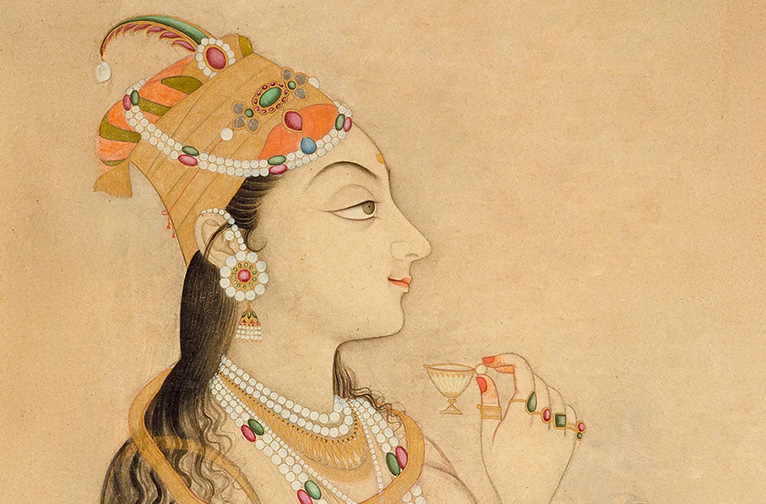
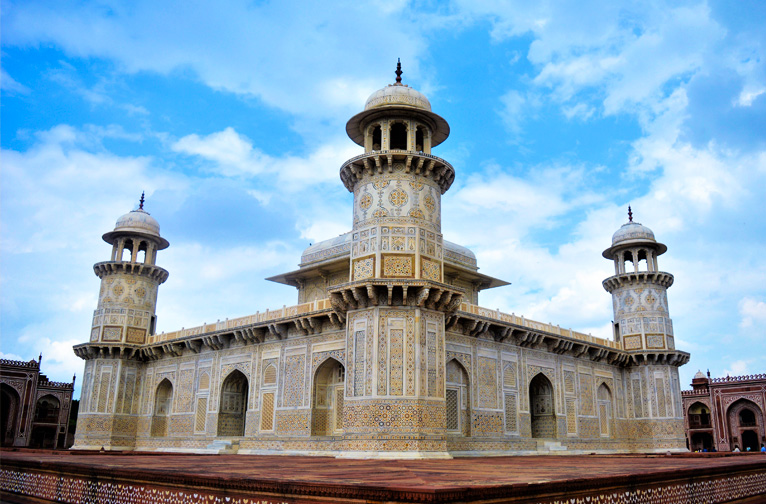
A woman of independent means and a power to be reckoned with as the Padshah Begum or first lady of the empire, Empress Nur Jehan was also a consummate aesthete who oversaw every detail of the white marble mausoleum she commissioned as the last resting place for her father Itimad Ud Daula. Also known as Mirza Ghiyas-ud-din, Itimad Ud Daula was an impoverished migrant nobleman of Persian descent who joined Akbar’s court. Over time, he worked his way up the ranks, gaining a reputation for being erudite, smart, and thoroughly corrupt. With his daughter getting married to Akbar’s son Jehangir, he became a man of high standing. On Jehangir’s accession to the throne, he became revenue minister. Later on, as Vizir at the court, he came to wield even greater power with the support of Nur Jehan.

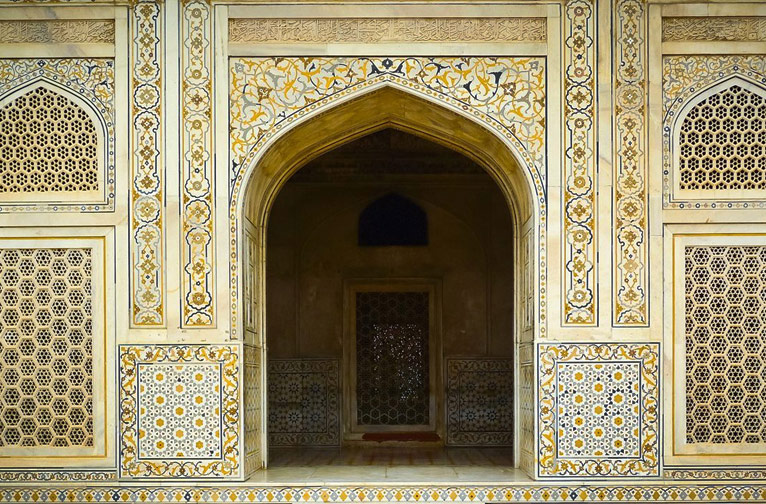
Both mausoleums serve as excellent examples of the great finesse achieved by Mughal architecture and its decorative features. A unique aspect of Itimad-ud-Daulah's tomb is that it represents the transition of Mughal edifices from red sandstone to white marble for the first time in India. While Akbar’s abandoned city of Fatehpur Sikri is a fine example of the stunning outcome of red sandstone as a building material on many counts, Itimad-ud-Daulah's tomb is built exclusively in pure white marble. Raised on top of a platform of red sandstone amidst lush gardens with intersecting walkways and serene water bodies, the pristine white marble square structure is also considered a superb representative of the Persian-inspired classic Charbagh Tomb adopted by the Mughals. Located on the ground floor of the tomb are the sarcophagi of Itimad-ud-Daula and his wife Asmat Begum. Surrounded by a protective wall, it is accessed through two beautiful gateways—one to the east, the other to the west, which also afforded access to riverfront views. Two dummy gateways also adorned the enclosure wall to maintain the symmetry of the structure. The gateways, clad in red sandstone, featured white marble inlay work in geometric patterns. The tomb is quite distinctive for its Persian inspirations.
We see two decorative elements of great note here in the Baby Taj—One of them is the delicate Italian-style pietra dura, marble inlay work with semi-precious stones, used for the first time and in great profusion in a Mughal structure. The other stunning feature is the Gujarati-inspired jali or lattice work, used with a lavish hand throughout the tomb. Both these decorative features were later on liberally adapted in the interiors and exteriors of the Taj Mahal. You will also have noted exquisite renditions of jali work on your visit to Humayun’s Tomb in Delhi and at the shrine of Sufi Saint Salim Chisti in Fatehpur Sikri. Carved panels of very fine calligraphy also make an appearance at several places in the 'Baby Taj'. The calligraphic works have been ascribed to a calligrapher named Abd al-Nabi al-Qarshi. Calligraphy, as a beautiful art form, is richly represented in the Taj Mahal’s decorative features as well.
The ‘Baby Taj’ is a modest structure in line with Itimad-ud-Daula’s status as a minister in Jehangir’s court. The Taj Mahal is the vision of a mighty emperor of immense wealth and power. With its sky-touching 60 meters, making it the tallest of all Mughal tombs built, it is recognised as the single greatest work of Mughal architecture. Clad in pristine white marble, the Taj Mahal took 20 years in the making according to the wishes of a grieving Shahjehan, who spared no expense in the pursuit of excellence for this memorial of love for his wife Mumtaz Mahal. A monarch of exquisite taste and fine sensibilities, Shahjehan had all the wealth of his kingdom to draw upon to fulfil his dream. A UNESCO-acclaimed World Heritage Site since 1982, it is one of India’s most iconic tourist attractions for the global travelling community. The Taj Mahal has earned this unique distinction as it ‘represents the finest architectural and artistic achievement through perfect harmony and excellent craftsmanship in a whole range of Indo-Islamic sepulchral architecture.’
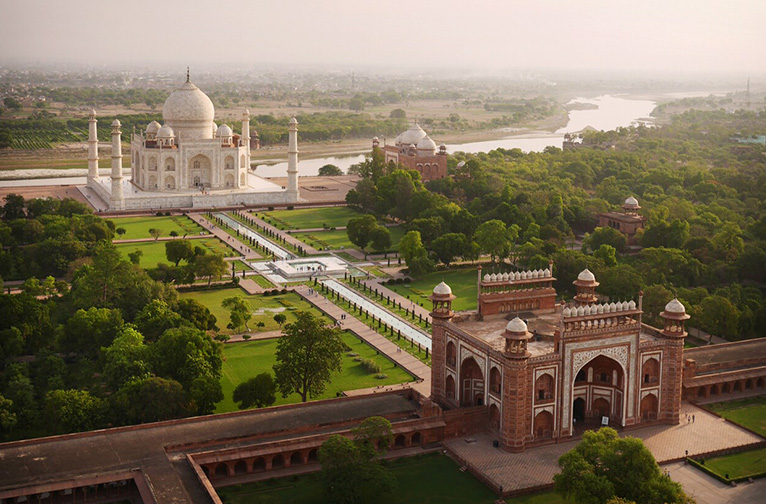
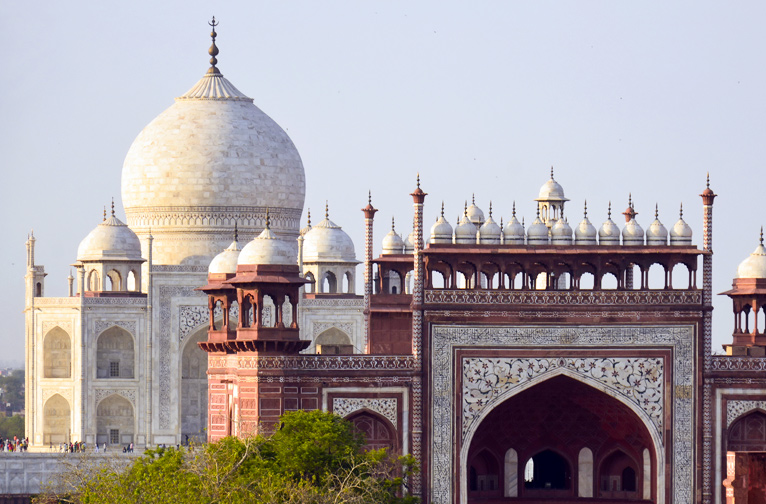
A perfectly symmetrical planned building, the massive Taj complex, set in the classic Char Bagh Garden Tomb fashion, was constructed with great care at every step. The masterly edifice comprises the mausoleum itself atop a 6.5-metre-high platform, with four free-standing minarets placed on the four corners, a mosque and guest house rendered in red sandstone, and an outer courtyard clustered with cloisters. The onion-shaped marble dome, raised over the tomb, the most spectacular feature, is accentuated as it has been set upon a 23-foot-high cylindrical "drum". The interiors and the exterior of the main building are a fabulous showcase for stunning decorative works, including inlay work, handcrafted jalis, and beautiful calligraphy.
Visitors enter the complex for viewing from the eastern gate. Its main architect was Ustad-Ahmad Lahori, who had at his command a massive influx of masons, stone-cutters, inlayers, carvers, painters, calligraphers, dome builders, and other artisans drawn not only from the four corners of his empire in Hindustan but also from faraway places in Central Asia and Persia. No extravagance was big enough to transform that blueprint into a stunning reality of grace and beauty and impeccable symmetry.
The actual graves of Mumtaz and Shahjehan are placed in a lower chamber and are no longer open to the public. The ones visitors see in the upper chamber are the dummy graves of the royal couple. This is quite a common occurrence in the imperial Mughal tombs.
The pure gold finial, which once stood atop the central dome of the Taj, was stolen in 1810 by a British officer, Joseph Taylor, according to records. Over time, several replacements were added to the void left behind by the original. In 1876, it had a copper finial gilded over with gold leaf. The one you see today was a replacement made in 1940.
A visit to Agra would be incomplete if you don’t explore the intriguing possibilities that link the Taj Mahal and the ‘Baby Taj’ in so many ways. This tale of the two Tajs is an alluring banquet of known and unknown facts… perfect for the curious adventurer!